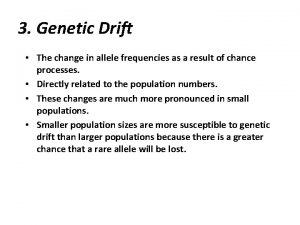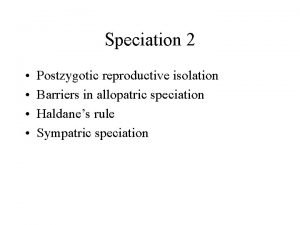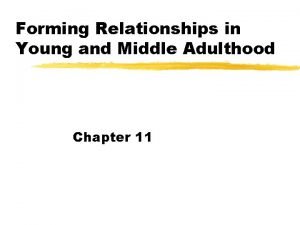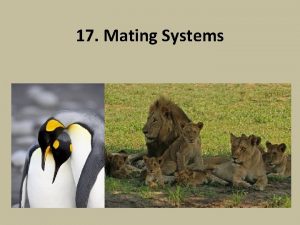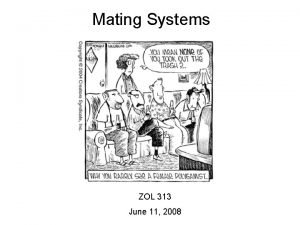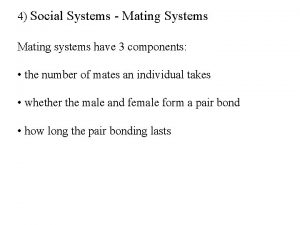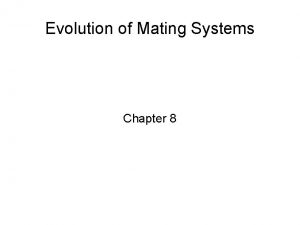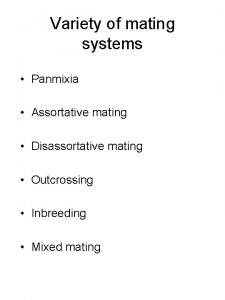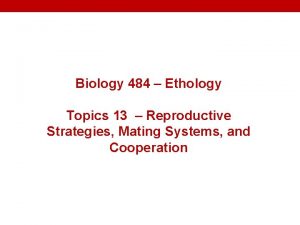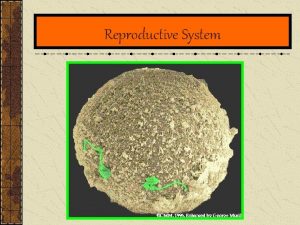SEXUAL STRATEGY SEXUAL STRATEGIES OR MATING The reproductive





















































- Slides: 53

SEXUAL STRATEGY

SEXUAL STRATEGIES OR MATING The reproductive success in all organisms depend upon the chances of mating relationships between the male and female partners but mating success is not the same for both sexes. Mating is a kind of social behavior that is adapted for the exchange of gametes.

The mating behavior may be summarized as (1) Synchronization, whereby two animals come together and are physiologically ready to produce, (2) Courtship, whereby the two animals breakdown one another’s tendency for physical avoidance, and (3) Copulation, whereby sex cells, usually sperm, are transferred.

SYNCHRONIZATION The synchronization generally occurs in the spring. Various birds, fish and mammals migrate towards their respective breeding grounds. This behavior is usually brought on by the lengthening of daylight, which triggers some internal mechanism which in turn causes the secretion of hormones, resulting in the growth of the sex glands. There may be a considerable variation between males and females. In certain animals, sign stimuli from the male are needed to induce reproductive behavior in the females, and in other cases the sign stimuli originate with the female

Courtship Reproductive behavior that takes place before copulation is referred to as courtship behavior. One function of courtship behavior is the identification of mates of the right sex and species. Where sexual dimorphism is present, males and females of the same species can recognize each other by their appearance.

• For example, the behavior of sexually mature male crested grebes differs from that of immature males or of females. The mature male displays by erecting his crest and holding his wings outspread to exaggerate the size of his body. • Male cycloids (a family of tropical fish) raise their dorsal fins and beat the water with their tails. Such behavior enables breeding partners to locate one another, even when they are separated by fairly great distances

COPULATION Behavior that takes place during the time of fertilization is called copulation. In lower vertebrates, certain kinds of behaviors help to coordinate the release of the eggs and sperm. For example, the male salamander strokes the female, thus stimulating here to release her eggs when it is present to fertilize them. In fish, the stimulus is often an erratic swimming pattern rather than a stroke.

ROLE OF STIMULI IN MATING BEHAVIOR Individuals of many species only come together during the mating season. Therefore, during this time members of a species must be attracted to each other. The sights and sounds of a breeding partner act as a stimulus for the secretion of hormones that induce courtship.

Among birds, frogs and certain insects there may by a specific song. In moths and dogs or cats a specific odor brings the individuals together. Many birds use visual stimuli such as attractive feathers, specific posture or change of colour during the mating season.

The mating group is generally classified into • Monogamy, • Polygamy, – Polygyny – Polyandry • Promiscuity and • other variations within each category,

Monogamy Here mating relationship between one male and one female at a time is found. This situation is seen in 90% birds, about 4% in mammals and 20% in human societies. Here life long breeding pairs live together, and if by chance single mate dies then only, new mate is accepted as found in gibbon. Typical monogamy is seen in the case of dik-dik, steenbok, songbirds, eagles, swan, foxes etc.

• Monogamy may be classified into three categories • (a) Male parental association, whether more or less or equal as compared to female parent, • (b) Extension of space or territoriality, • (c) Temporal relationships.

1. The male parental association is further classified into three categories: (i). Facultative Monogamy: The female parental investment is more than the male parental investment. This is seen in the case of wood duck and Bewick’s swans.

(ii). Obligate Monogamy: Here female parental investment is equal to male parental investment as seen in the case of pelicans, herring gulls etc. This is called obligate monogamy.

(iii). Here female spend less time in rearing the young ones. Instead of female, males spend more time and energy to rear the young ones as reported in the case of golden lion tamarin.

2. The spatial or extension of territoriality is further distinguished into following categories: • (i). Territorial Monogamy: Here monogamous pair as seen in gibbon shares a common territory, golden lion tamarin where both male and female defends territory. This is called territorial monogamy.

(ii). Defense Monogamy: Here each male instead of defending territory protects the female. This is called female defense monogamy.

3. The temporal relationships is further sub classified into two categories depending on the temporal relationships between male and female. (i). Serial Monogamy: During one breeding season or for a year male and female come close with each other to develop a bond between themselves as found in sparrow, warblers etc. This is known as serial monogamy.

(ii). Perennial Monogamy: Here male and female live together throughout life and both parents invest equally in the offspring e. g. kittiwake bird, geese, Siberian cranes, swans etc. This is called perennial monogamy.

Polygamy In this multiple mating takes place between one individual of one sex with several of another sex. It is categorized into two categories viz. Ø Polygyny and Ø Polyandry.

a. Polygyny: Here mating occurs between single male and two or more females at a time. The phenomenon is called as Polygyny. This is common among mammals. This is further subdivided into two categories.

(i). Territorial Polygyny: Male forms separate mating pairs where each one is associated with two or more females and they keep them in their territories during breeding season

(ii). Harem Polygyny: In this a group is formed where dominance hierarchy is seen where male remain dominant in rank order which becomes leader of the group which is called alpha animal and the lowest in the series is called omega animal. The most dominant male possesses a group of females called harem. A female resource polygyny is seen where a male protects a group of females and mates with them.

In many mammals like lion, langoors, antelopes, deer, etc. females form smaller societies or groups, which are generally visited by males during the mating season. In the other type of polygyny called male dominance polygyny, dominance hierarchy decides the mating privileges among males. This is known as lek formation as seen in sager grouse, fishes and mammals. The area, which is known as a lek, a number of males competes with each other for the possession of very small mating territories.

(iii). Resource Oriented Polygyny: The males defend the habit or home range, where the female groups aggregate. They then mate with the visiting females, e. g. in impala, browsers of African grassland, females congregate together and remain in areas, where plenty of food is available and the dominant males defend the territory as well as the harem females.

In the 3 spine sticklebacks, the males possessing larger territories attract large number of females for mating and nesting. In dickcissel, a bird found in USA, the males guard dense vegetation areas as it attracts more females.

(iv). Serial Polygyny: In serial polygyny a male is bonded with many females during mating season but it acquires only single female at a time as seen in the case of dogs and 3 spine sticklebacks. In dogs, males mate one bitch after another without making groups.

(v). Simultaneous Polygyny: Here polygynous males mate many females after making groups as seen in langoors, furseals, elk, etc.

b. Polyandry: This is a rare phenomenon seen in animals where a reversal of role of two sexes takes place, in this one female is bonded with many males and mating occurs with two or more males at a time. This is common in birds. This is further subdivided into following subcategories:

(i). Non-territorial polyandry: In this females do not form a territory and it leaves its first male and pairs with a new partner.

(ii). Territorial polyandry: The females form territory where mates visit for mating as seen in Jacana bird.

(iii). Successive polyandry: Here temporary pair bonds develops for breeding purposes as reported in case of shore birds where temporary pairs are formed and after laying clutches from their first mates, they leave them and repeat the cycle with another male.

(iv). Simultaneous polyandry: This is seen in Jacanas where polyandrous female acquires all their mates at the same time. In Jacanas the female defend large territories which are further broken into smaller territories which are ultimately defended by a male.

The female visits such male territories and mates with them and laying eggs, which are further incubated not by the females but by the respective males in the floating nest in the pond.

c. Promiscuity: In promiscuity durable mating relationships are not seen and the number of both sexes mate randomly with several individuals. No long term association develops between two sexes, the mating may or may not be multiple in number by promiscuous animals as seen in the case of Chimpanzees, bears, grouse, etc. This is classified into following sub-categories:

(i). Hierarchical promiscuity: Here males form dominance hierarchies in mating the females as reported in elands, Oryx, etc.

(ii). Overlap promiscuity: Here mating occurs between solitary individuals with overlapping of the home ranges e. g. rodents.

(iii). Lek promiscuity: Here male attracts female in its defended territory as seen in sage grouse, Ugandan antelope cob.

(iv). Broadest Promiscuity: Those species which have short breeding seasons come together to breed in large numbers e. g. in frogs, breeding season lasts for only two days during which spawning and mating occurs randomly. This is also seen in fishes.

EXAMPLES OF COURTSHIP AND MATING IN ANIMALS Mating in Arachnids (a). Scorpions: In scorpions, the male not only stimulates the female sexually but he has to suppress the non-sexual behavior of the female so that she may not eat him. In ethological terminology, the function of courtship is to provide releaser stimuli which block hunger drive.

In scorpions, courtship takes the form of a dance called ‘promenade a deus’ by Fabre. On finding a suitable mate, the two scorpions stand face to face with their tails upraised and move about in circles; in some other species, the male rocks. The male then seizes the female with his pedipalps, and together they walk backward and forward (promenade).

The behavior may last from 10 min to hours, depending on how long it takes to locate a suitable site for spermataphore deposition. Eventually, the male deposits a spermataphore which he attaches to the ground. A wing-like lever extends from the spermataphore. The male then maneuvers the female so that her genital area is over the spermataphore. Pressure on the lever of spermataphore releases the sperm mass, which is taken up into the female orifice. Thus, in scorpions, coitus does not occur.

• (b). Mating in Spiders: Spiders are predatory animals. They are ready to kill and eat the animals of small size that come within their range. Female spiders are cannibalistic too. So mating in spiders is difficult and quite dangerous for the male who is smaller and weaker. Under these circumstances, male courtship behavior has dual functions: it stimulates female sexually on one hand suppresses female’s non-sexual behavior on the other hand.

• Some species of spiders employ a mechanical mean of attracting the opposite sex. Male spiders approach the web of a female sitting at the centre of the web and pluck a thread of the web at the species-specific frequency. The plucking ‘ serenades’ the female and reduces her natural aggressive manner so enabling the male to approach and mate her. Unfortunately if the male “woos” a female of the wrong species or ‘plays the wrong tune’ he is attacked and killed.

• In some species, male spiders present the female with a nuptial gift in the form of an insect wrapped in silk. While the female unwraps the gift and eat the insect, the male is able to mate with her, without being attacked. In spiders, the mating procedure is also quite unique. Male weaves a small pad of silk on which a drop of sperm is deposited and this is sucked up by specially modified pedipalps. In due course of time, this is inserted in the vagina of the female

• Courtship in birds: In birds, phenomena of display and courtship attain a complexity incompatible to human beings. A bird’s song is often an initial feature of the ritual which first attracts and excites the female. The male bird is frequently aggressive in defense of his territory. Consequently, courtship in females often takes the form of reactions which tend to avoid provoking of the attack. For example, female kestrels (a European falcon, Falco tinnuculus) show infantile behavior reminding the appeasement employed by the young. Courtship ceremony begins by offering food to each other which is a behavior pattern carried over from infancy.

In avocets (Long-legged shore birds of Genus Recurvirostra) having webbed feet and slender up-curved bill, male and female both preen their feathers in a hasty fashion during courtship. After preening when the female adopts a characteristics flattened posture indicating her readiness for the mating only, then male mounts and copulates.

Indian peacock is a polygynous bird. During breeding seasons, cock forms a drove or harem of 4 to 5 peahens. The courtship behavior of peacock is very fascinating. While courting behavior, the peacock spread its beautiful tail whenever a peahen approaches but as she comes near him he takes an about turn showing her his rear portion. If peahen is ready for mating, she would run swiftly around the tail to be able to see him front again. The peacock responds by rustling his tail feather. Then he will turn around again and this courtship game will be repeated several times. At last the peahen will lie down in front of him giving signals for mating.

• Mating in Mammals: In mammals, olfaction plays a major role in the regulation of courtship behavior. After smelling a female, the males of many species display a response in which neck is extended and the upper lip is curled (e. g. , males of cow, buffalo, ass, etc. ). Females often ask for mountings. Sometime by approaching a male she muzzles or licks him. Often she runs away from the male when approached but appears again a solicitation behavior starts and then she escapes.

• In case of red deer, the female deer (hind) frequently runs away when approached by the male deer (stag) but she soon stops and waits for him. She licks him and then runs again only to wait once more for his approach. In bottlenosed dolphins, vocalization, nuzzling of partner’s genitalia, rubbing of bodies, stroking with flippers, displaying of the underside, chasing, and head butting occur during courtship

Conclusion Social Organization helps the animals in different ways. It is evident that organization has survival value because a high proportion of species have become organized. Even the most primitive forms, which, relatively speaking, have no true organization, may develop some simple types of grouping.

The survival value of organization occurs in two distinct areas of value to the species. The first area is the maintenance activities, of which feeding and avoidance of predators are examples. The second area encompasses the reproductive activities.

 Non random mating
Non random mating Assortative mating
Assortative mating Assortative mating
Assortative mating Canine mating cont
Canine mating cont What is phylum zygomycota
What is phylum zygomycota Glomeromycota
Glomeromycota Exams on strategic staffing
Exams on strategic staffing Hình ảnh bộ gõ cơ thể búng tay
Hình ảnh bộ gõ cơ thể búng tay Lp html
Lp html Bổ thể
Bổ thể Tỉ lệ cơ thể trẻ em
Tỉ lệ cơ thể trẻ em Chó sói
Chó sói Tư thế worms-breton
Tư thế worms-breton Bài hát chúa yêu trần thế alleluia
Bài hát chúa yêu trần thế alleluia Các môn thể thao bắt đầu bằng tiếng bóng
Các môn thể thao bắt đầu bằng tiếng bóng Thế nào là hệ số cao nhất
Thế nào là hệ số cao nhất Các châu lục và đại dương trên thế giới
Các châu lục và đại dương trên thế giới Công thức tính độ biến thiên đông lượng
Công thức tính độ biến thiên đông lượng Trời xanh đây là của chúng ta thể thơ
Trời xanh đây là của chúng ta thể thơ Mật thư anh em như thể tay chân
Mật thư anh em như thể tay chân Phép trừ bù
Phép trừ bù độ dài liên kết
độ dài liên kết Các châu lục và đại dương trên thế giới
Các châu lục và đại dương trên thế giới Thể thơ truyền thống
Thể thơ truyền thống Quá trình desamine hóa có thể tạo ra
Quá trình desamine hóa có thể tạo ra Một số thể thơ truyền thống
Một số thể thơ truyền thống Cái miệng nó xinh thế chỉ nói điều hay thôi
Cái miệng nó xinh thế chỉ nói điều hay thôi Vẽ hình chiếu vuông góc của vật thể sau
Vẽ hình chiếu vuông góc của vật thể sau Nguyên nhân của sự mỏi cơ sinh 8
Nguyên nhân của sự mỏi cơ sinh 8 đặc điểm cơ thể của người tối cổ
đặc điểm cơ thể của người tối cổ V. c c
V. c c Vẽ hình chiếu đứng bằng cạnh của vật thể
Vẽ hình chiếu đứng bằng cạnh của vật thể Vẽ hình chiếu vuông góc của vật thể sau
Vẽ hình chiếu vuông góc của vật thể sau Thẻ vin
Thẻ vin đại từ thay thế
đại từ thay thế điện thế nghỉ
điện thế nghỉ Tư thế ngồi viết
Tư thế ngồi viết Diễn thế sinh thái là
Diễn thế sinh thái là Dot
Dot Số.nguyên tố
Số.nguyên tố Tư thế ngồi viết
Tư thế ngồi viết Lời thề hippocrates
Lời thề hippocrates Thiếu nhi thế giới liên hoan
Thiếu nhi thế giới liên hoan ưu thế lai là gì
ưu thế lai là gì Sự nuôi và dạy con của hổ
Sự nuôi và dạy con của hổ Khi nào hổ con có thể sống độc lập
Khi nào hổ con có thể sống độc lập Hệ hô hấp
Hệ hô hấp Từ ngữ thể hiện lòng nhân hậu
Từ ngữ thể hiện lòng nhân hậu Thế nào là mạng điện lắp đặt kiểu nổi
Thế nào là mạng điện lắp đặt kiểu nổi Corporate strategy and business strategy
Corporate strategy and business strategy Home replication strategy example
Home replication strategy example Example of aggregate planning
Example of aggregate planning Multidomestic strategy example
Multidomestic strategy example Aligning hr strategy with business strategy
Aligning hr strategy with business strategy
